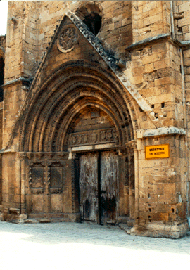
Bedestan
 On
the south side of the Selimiye is a Greek church built in the
Byzantine and
mediaeval styles. It is called the Bedestan, meaning covered market, and this it
was, until the municipal market moved to buildings on the other side of the
road.
On
the south side of the Selimiye is a Greek church built in the
Byzantine and
mediaeval styles. It is called the Bedestan, meaning covered market, and this it
was, until the municipal market moved to buildings on the other side of the
road.
The building was constructed in
the 12th century as a Byzantine church (The St. Nicholas Church). It was later
enlarged by some Gothic annexes built by the Lusignans.
After some more changes in the Venetian
period, the building was given to the Greek Orthodox Metropolis.

The
building with its different architectural styles is of a hybrid nature.
In the Ottoman
period, it served as a depot and a market where mostly textile products were
sold.
The masonry on its northern
entrance resembles the masonry on the entrance of the St. Sophia Cathedral.
The Bedestan is now preserved as an ancient monument and the interior has
many fallen marble and granite columns, probably Roman, and it shows that the
Bedestan was once a much larger church.
 Looking around the church, one can still
see the effects of the severe earthquakes of centuries ago. The guide will show
you a vaulted room full of mediaeval tombstones, many having the coats of arms
of crusader knights.
Looking around the church, one can still
see the effects of the severe earthquakes of centuries ago. The guide will show
you a vaulted room full of mediaeval tombstones, many having the coats of arms
of crusader knights.
The best photograph to take is that of the beautifully
carved Gothic door on the northern side. It is a good example of French
mediaeval stone carving. Quite a mystery is why two such large churches were
built so close together.
 The two tall minarets of the
Selimiye mosque form a very prominent landmark in Nicosia. Coming down from the
mountains on the Kyrenia road, and just before reaching Gönyeli, one can
pinpoint Nicosia by these twin towers.
The two tall minarets of the
Selimiye mosque form a very prominent landmark in Nicosia. Coming down from the
mountains on the Kyrenia road, and just before reaching Gönyeli, one can
pinpoint Nicosia by these twin towers.
The next time you fly over
Nicosia, you will hardly notice the mosque, but most conspicuous of all are the
Venetian encircling walls with their eleven polygonal bastions.
References
-
Dreghorn, W.,
The
Antiquities of Turkish Nicosia, Rustem Publishers, Nicosia.

 On
the south side of the
On
the south side of the 

